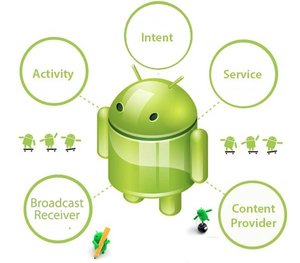History of Android
The history and versions of android are interesting to know. The code names of android ranges from A to J currently, such as Aestro, Blender, Cupcake, Donut, Eclair, Froyo, Gingerbread, Honeycomb, Ice Cream Sandwitch, Jelly Bean, KitKat and Lollipop. Let's understand the android history in a sequence.1) Initially, Andy Rubin founded Android Incorporation in Palo Alto, California, United States in October, 2003.
2) In 17th August 2005, Google acquired android Incorporation. Since then, it is in the subsidiary of Google Incorporation.
3) The key employees of Android Incorporation are Andy Rubin, Rich Miner, Chris White and Nick Sears.
4) Originally intended for camera but shifted to smart phones later because of low market for camera only.
5) Android is the nick name of Andy Rubin given by coworkers because of his love to robots.
6) In 2007, Google announces the development of android OS.
7) In 2008, HTC launched the first android mobile.
Android Versions, Codename and API
Let's see the android versions, codenames and API Level provided by Google.***...............................................................***Android Architectureandroid architecture or Android software stack is categorized into five parts: | ||||||||||||||||||||||||||||||||||||||||||||
|---|---|---|---|---|---|---|---|---|---|---|---|---|---|---|---|---|---|---|---|---|---|---|---|---|---|---|---|---|---|---|---|---|---|---|---|---|---|---|---|---|---|---|---|---|
1) Linux kernelIt is the heart of android architecture that exists at the root of android architecture. Linux kernel is responsible for device drivers, power management, memory management, device management and resource access.2) Native LibrariesOn the top of linux kernel, their are Native libraries such as WebKit, OpenGL, FreeType, SQLite, Media, C runtime library (libc) etc.The WebKit library is responsible for browser support, SQLite is for database, FreeType for font support, Media for playing and recording audio and video formats. 3) Android RuntimeIn android runtime, there are core libraries and DVM (Dalvik Virtual Machine) which is responsible to run android application. DVM is like JVM but it is optimized for mobile devices. It consumes less memory and provides fast performance.4) Android FrameworkOn the top of Native libraries and android runtime, there is android framework. Android framework includes Android API's such as UI (User Interface), telephony, resources, locations, Content Providers (data) and package managers. It provides a lot of classes and interfaces for android application development.5) ApplicationsOn the top of android framework, there are applications. All applications such as home, contact, settings, games, browsers are using android framework that uses android runtime and libraries. Android runtime and native libraries are using linux kernal.***........................................................................................................*** Android Core Building Blocks An android component is simply a piece of code that has a well defined life cycle e.g. Activity, Receiver, Service etc.
An android component is simply a piece of code that has a well defined life cycle e.g. Activity, Receiver, Service etc. The core building blocks or fundamental components of android are activities, views, intents, services, content providers, fragments and AndroidManifest.xml. ActivityAn activity is a class that represents a single screen. It is like a Frame in AWT.ViewA view is the UI element such as button, label, text field etc. Anything that you see is a view.IntentIntent is used to invoke components. It is mainly used to:
ServiceService is a background process that can run for a long time.There are two types of services local and remote. Local service is accessed from within the application whereas remote service is accessed remotely from other applications running on the same device. Content ProviderContent Providers are used to share data between the applications.FragmentFragments are like parts of activity. An activity can display one or more fragments on the screen at the same time.AndroidManifest.xmlIt contains informations about activities, content providers, permissions etc. It is like the web.xml file in Java EE.Android Virtual Device (AVD)It is used to test the android application without the need for mobile or tablet etc. It can be created in different configurations to emulate different types of real devices. | ||||||||||||||||||||||||||||||||||||||||||||
| ***.........................................................................................................*** | ||||||||||||||||||||||||||||||||||||||||||||


No comments:
Post a Comment